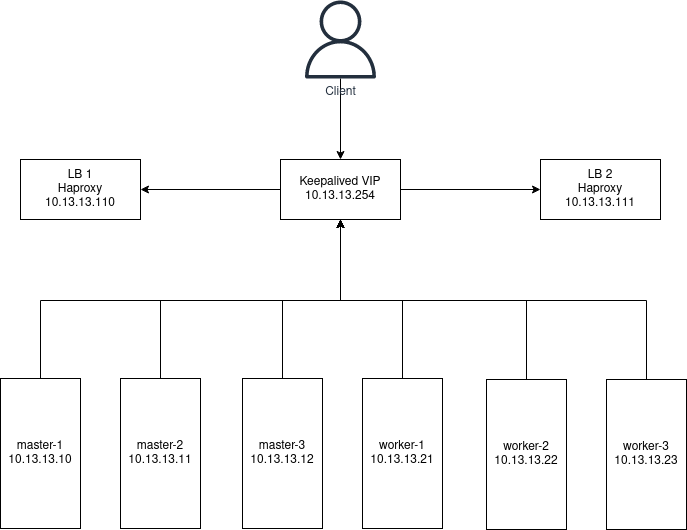Topology:#

Loadbalancer Haproxy with keepalived as kube api server for the cluster, which provide High availability. The Loadbalancer machine gets virtual IP from keepalived to keep kube api server endpoints always availabilty, then the haproxy allow us to provide loadbalancing for each master node api server.
Loadbalancer preparation#
1. Setup haproxy on loadbalancer node#
1
2
3
4
5
6
7
8
9
10
11
12
13
14
15
16
17
18
19
20
21
22
23
24
| # do it on LB1 and LB2
# Update package and install haproxy
apt update
apt install haproxy -y
# edit haproxy.cfg
nano /etc/haproxy/haproxy.cfg
---
listen kubernetes-apiserver-https
bind *:6443
mode tcp
option log-health-checks
timeout client 3h
timeout server 3h
server master-1 10.13.13.10:6443 check check-ssl verify none inter 10000
server master-2 10.13.13.11:6443 check check-ssl verify none inter 10000
server master-3 10.13.13.13:6443 check check-ssl verify none inter 10000
balance roundrobin
---
# restart haproxy
systemctl restart haproxy.service
|
2. Setup keepalived on loadbalancer node#
1
2
3
4
5
6
7
8
9
10
11
12
13
14
15
16
17
18
19
20
21
22
23
24
25
26
27
28
29
30
31
32
33
34
35
36
37
38
39
40
41
42
43
44
45
46
47
48
49
50
51
52
53
54
55
56
57
58
59
| # do it n LB1 and LB2
# install keepalived
apt install keepalived
# edit keepalived.conf
nano /etc/keepalived/keepalived.conf
---
router_id LVS_DEVEL
enable_script_security
}
vrrp_script keepalived_health {
script "/etc/keepalived/keepalived_check.sh"
interval 1
timeout 5
rise 3
fall 3
}
vrrp_instance LB_K8S_CALICO_VIP {
state BACKUP
nopreempt
interface ens3
virtual_router_id 66 # 67 for LB2
priority 100 # 101 for LB2
authentication {
auth_type PASS
auth_pass 2kwz5Vqt
}
unicast_src_ip 10.13.13.110 # reverse for LB 2
unicast_peer {
10.13.13.111
}
virtual_ipaddress {
10.13.13.150/32
}
track_script {
keepalived_health
}
}
---
# make health check scripts
nano /etc/keepalived/keepalived_check.sh
---
#! /bin/bash
/usr/bin/ping -c 1 -W 1 virtual_ipaddress > /dev/null 2>&1
--
# restart keepalived
systemctl restart keepalived.service
# check vip
ip a show ens3
|
Kubespray preparation#
First of all, make sure you already setup the kubespray and ready to go.
3. Make virtual environment#
1
2
| python3 -m venv venv
source venv/bin/activate && cd kubespray
|
4. Make inventory file#
1
2
3
4
5
6
7
8
9
10
11
12
13
14
15
16
17
18
19
20
21
22
23
24
25
26
27
28
29
30
31
32
33
| cp -frp inventory/sample inventory/your-inventory-dir
nano inventory/your-inventory-dir/your-inventory.ini
---
[all]
master-1 ansible_host=10.13.13.10 ip=10.13.13.10
master-2 ansible_host=10.13.13.11 ip=10.13.13.11
master-3 ansible_host=10.13.13.12 ip=10.13.13.12
worker-1 ansible_host=10.13.13.21 ip=10.13.13.21
worker-2 ansible_host=10.13.13.22 ip=10.13.13.22
worker-3 ansible_host=10.13.13.23 ip=10.13.13.23
[kube_control_plane]
master-1
master-2
master-3
[etcd]
master-1
master-2
master-3
[kube_node]
worker-1
worker-2
worker-3
[calico_rr]
[k8s_cluster:children]
kube_control_plane
kube_node
calico_rr
---
|
5. Testing connection#
1
| ansible-playbook -i inventory/your-inventory-dir/your-inventory.ini all -m ping
|
6. Edit k8s-cluster.yml#
1
2
3
4
5
6
7
8
9
10
11
12
13
14
| nano inventory/your-inventory-dir/group_vars/k8s_cluster/k8s-cluster.yml
---
# line 20 define kubernetes version
kube_version: v1.25.4 # depending on what you want
# line 70 CNI plugin
kube_network_plugin: calico # caico,flannel .etc
# line 76 define internal network for service
kube_service_addresses: 10.233.0.0/18
# line 81 define pods subnet
kube_pods_subnet: 10.233.64.0/18
# line 224 define container manager
container_manager: containerd
---
|
7. Edit all.yml#
1
2
3
4
5
6
7
8
9
| nano inventory/your-inventory-dir/group_vars/all/all.yml
---
## External LB example config
apiserver_loadbalancer_domain_name: "elb.master.local" # your domain or local domain
loadbalancer_apiserver:
address: 10.13.13.150 # LB VIP
port: 6443
---
|
8. Run kubespray ansible#
1
| ansible-playbook -i inventory/your-inventory-dir/your-inventory.ini --become --become-user=root cluster.yml
|
9. Enable bash completion#
1
2
3
4
| # Bash auto complete
echo 'source <(kubectl completion bash)' >>~/.bashrc
echo 'alias k=kubectl' >>~/.bashrc
echo 'complete -o default -F __start_kubectl k' >>~/.bashrc
|
Your cluster is ready!#
